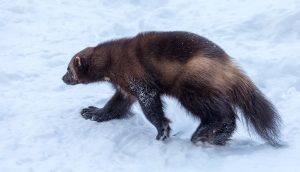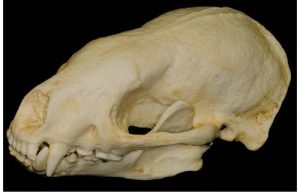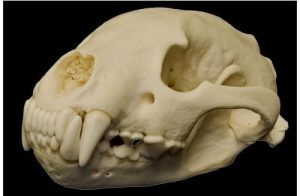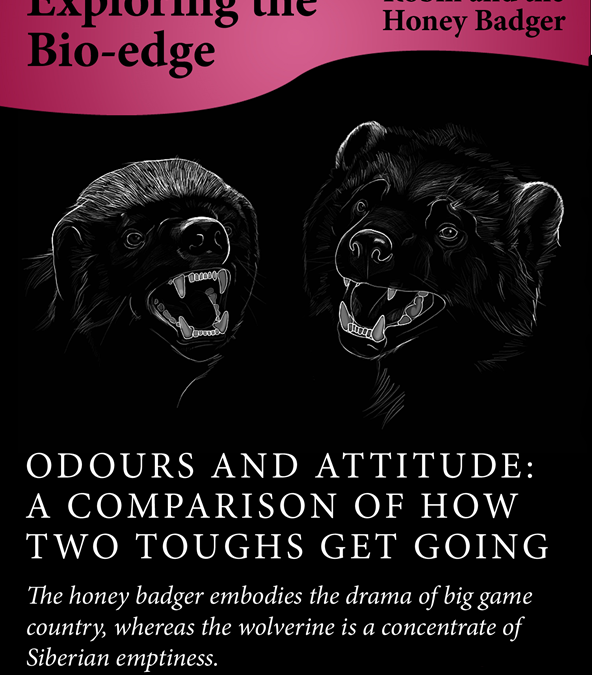
The honey badger embodies the drama of big game country, whereas the wolverine is a concentrate of Siberian emptiness.
The honey badger and the wolverine are mustelids with churlish public images and larger-than-life reputations. Both species share robust constitutions and defensive tactics with other terrestrial mustelids and are relatively large for this family of carnivores. In this exposition we focus on the real similarities between honey badger and wolverine and, perhaps more importantly, their real differences.
Our two species are stocky, masked, thick-skulled, vice-jawed, pugnacious, enterprising, restless, unsociable, part-climbing, trap-mangling, wide-roaming opportunists. The list of similarities continues. In both species: a mixture of bluff, tough and venom is used to intimidate carnivores much larger than their own body mass of some 10 kilograms; odours are used as weapons and tonally contrasting coats warn predators of this risk; growth is slow; breeding is slow, weaning one or two young every other year; lifespan is long relative to other carnivores; and males are larger than females.
Unfortunately, reports of the honey badger and wolverine have been so exaggerated that it takes a balanced scrutiny to penetrate the layers of hearsay, and to edit the emotive and anthropocentric biases that have affected even the scientific literature on our two species. With this in mind, let’s re-assess the distribution, habitat, colouration, defences, locomotion, dentition, diet, intelligence, and other features of the honey badger and the wolverine. We’ll find that actual observation plus sensible interpretation redefines their mystique without dulling their colourful characters.
We start with distribution and habitat because these give us a basic insight into the most likely reasons for adaptive similarity as well as difference between our two species. Notably, their distributions do not overlap. While the honey badger occurs in Africa and southern Asia in cool to warm scrub, savanna, and woodland, the wolverine occurs across the vast tracts of conifers on permafrost in the far North. Their closest approach, in central Asia, still leaves thousands of kilometres penetrated by neither species on the Tibetan Plateau. Given the distance separating these species, their similarity of body size and form raises the question of whether the two are ecological equivalents. And their extensive distributions raise a further question of why no life-form equivalent to the honey badger occurs in central and South America, southeast Asia, or Australia, despite climatic similarities with Africa. This puzzling absence of a feisty large mustelid over much of the globe can perhaps be understood in terms of the real adaptations of the honey badger and wolverine. So let’s continue our sober scrutiny of the habits and adaptations of our species as we reveal the true dramas of their lives.
If we examine the environmental constraints on each species, we find that the habitat of the honey badger is not just climatically and botanically different from that of the wolverine. One species inhabits that surface of the earth most crowded with dangerous animals, whereas the other is itself among the few dangerous animals. Indeed, the honey badger is associated not as much with any particular climate as with a zone of extreme predatory intensity, namely those parts of Africa to southern Asia that support hyenas and the lion, or did so until recently. By contrast, the wolverine is associated with a climatic zone near the Arctic Circle that supports few predators.
Whether in the public eye or through our spectacles, both honey badger and wolverine are formidable fighters and able to squirt from anal glands, in parallel with skunks and polecats, what amounts to a venom. Indeed, the emissions of the honey badger are noxious to enemies as inured as the spotted hyena, while those of the wolverine are offensive enough to challenge even brown and black bears for possession of carcases.
The blurred distinction between defensiveness and offensiveness in our two species may be shown by the inverted colouration pattern that they share. The whole bodies of both species are aposematic in having an ominous blackish below and pale above – which is particularly striking in the provocatively pale skullcap above masked eyes (see Figures 1 and 2). Although the crown and flank-band are not as pale in the wolverine as in the honey badger, the body of the Northern species is dark enough overall to be conspicuous in its snowy environment – an ominous incongruity with the various coexisting mammals and birds that turn white in winter.

Figure 1. The honey badger, showing the typical posture and colouration of the species and the long fore-claws, small eyes, and rudimentary ears. Figure 1. The honey badger, showing the typical posture and colouration of the species and the long fore-claws, small eyes, and rudimentary ears. The honey badger (Mellivora capensis) by Sumeet Moghe (CC BY-SA 4.0, Adult Honey Badger).


Figure 2. The wolverine, showing the typical posture and colouration of the species in its snowy habitat, as well as the distinct ears and large feet with relatively short fore-claws. The wolverine (Gulo gulo) by Ninara (CC BY2.0, Wolverine).
Although the aposematic inversion in the colouration in both species is obvious, another difference in how the two display and announce themselves in challenge to other species is partly hidden on the ventral surface of the body. In common with several other mustelids and bears – but not the honey badger – the wolverine has an expletive pattern of pale patches on an otherwise dark throat and chest which it advertises in reaction to threats by lifting its head, sitting up, or even standing bipedally. By contrast the honey badger, which seems unable to stand or sit freely on its hindquarters, reacts by lowering its head and either advancing with a defiantly raised tail or scuffling rapidly backwards in retreat. Emphasising an audible rather than a visible challenge, the honey badger screams startlingly on first encounter and, when antagonised, growls more deeply than expected for its body size – a habit reflected in various onomatopoeic names including ratel in Afrikaans, nkarungurungi in KiMaasai, and entahurra in Luganda. Although the wolverine growls and hisses in annoyance like most carnivores, it lacks a corresponding reputation for guttural loudness.
The visual and vocal bravado of the honey badger also involves armour: its unusually thick and flexible skin, which manages somehow to combine a taut appearance with a loose attachment to the body, while being capable of resisting bites, buckshots, and impalement. Importantly, the extreme swivelling of its hide – unexpected in such a trim mammal – allows the honey badger to bite back at the very face of a large carnivore that attempts to grip it from above. The wolverine doesn’t appear to be armoured in the same way. Its pelt is certainly far better-known than that of the honey badger after centuries of fur-trapping in the far North, but even those prone to exaggerating the impunity of this species have attributed neither toughness nor looseness to its skin.
Although there are surprising differences in their skins, it’s the external ears of our two species that differ categorically because of their different tactics in self-defence. Based on their climatic adaptations, we would have expected – in line with other cold-tolerant mammals that have reduced all heat-losing surfaces of the body – the wolverine to have the smaller ear pinnae. However, the opposite is true. It’s rather the honey badger that is unusual for a carnivore – particularly a tropical one – in lacking distinct auricles, despite having good hearing and wide ear openings. This reduction of the ear pinnae of the honey badger is poorly explained by its commitment to excavating its food – especially in view of the obvious ears of other species of badgers and the particularly large ears of other digging mammals sharing its habitat. However, the reduction in the external ears in the honey badger is consistent with the toughness and looseness of the rest of its skin: it minimises surfaces exposed to stings and bites as well as the grip of large enemies such as the spotted hyena.
Continuing our balanced scrutiny, we turn to the next aspect: locomotion. Both the honey badger and the wolverine have massive forepaws and versatile limbs and are consequently capable climbers, swimmers, runners and diggers. If we were to set aside these relatively superficial similarities, we could characterise their locomotory differences as follows: the honey badger is essentially an earthmover whereas the wolverine is essentially a snowmobile. This is because the first species has bare soles, like most plantigrade carnivores, whereas the second has partly furred soles for insulation, emulating its occasional prey, the snowshoe hare. Admittedly, the wolverine excavates snow to make deep dens, and is capable of seasonally digging out ground squirrels to kill them, and then digging them back into the earth as a cache for later consumption. But it’s the honey badger that digs every day for its staple diet.
Further evidence for the dedication of the honey badger to earthmoving is the sheer length of fore-claws two, three, and four, which exceeds even that of the European badger. The fore-claws of the wolverine, although conspicuously pale against the dark fur of the paws, are short relative to bears as well as the honey badger; however they remain sharp because they don’t normally contact ground surfaces other than ice. We suspect that the fore-claws of the wolverine are designed to remain sharp whereas those of the honey badger are designed to resist wear. This apparent difference is reflected in their approach to tree-climbing. Partly by virtue of hind-claws that are longer than those of the honey badger, the wolverine can cling to tree trunks in a cat-like manner, and relies on climbing quickly enough in emergencies to evade its main enemy – the wolf. By contrast the honey badger is unknown to climb trees when in mortal peril; and when it climbs for food, it seems happy simply to fall the last three metres in its descent.
When it comes to horizontal movement, the honey badger consistently trots with its back held low and straight, whereas the wolverine canters with a flexed back and, unlike the honey badger, is able to jump. Indeed, the running gaits of our two species are significantly different despite their similar body forms. This presumably reflects the extremely long fore-claws of the honey badger, which prevent the animal landing on its forepaws, and the adaptation of the wolverine to snow and rocks. The limb actions also differ according to their respective modes of deep digging versus fleet-footed scurrying over snow.
Having scrutinised their locomotion, we turn to the next aspect in our balanced comparison: diet. Although both species forage year-round and have relatively broad and unfussy tastes, the honey badger and the wolverine depend essentially on venomous prey and well-preserved or cached carrion, respectively. Both species are certainly opportunistic enough to help themselves to the flesh of large mammals – even if this means driving large carnivores temporarily from their kills. And this proves that the honey badger ranks above its weight among African carnivores. However, only the wolverine actually kills prey as massive as the moose – the largest animal in its habitat – for food. Although we acknowledge the aggressive defences of the honey badger against superior carnivores, and the plausibility of its reputation for occasionally injuring large herbivores in bad temper, the staple diet of the honey badger is not large herbivores but rather invertebrates (such as scorpions, termites, hymenopteran insects, and large dung beetles[my understanding is that they relish the larvae, rather than the beetles…? They dig up the dung balls, with the larvae inside…we mention that in our book chapter on SA soils; and I saw evidence of it now in South Luangwa]), reptiles (including monitor lizards, hard-shelled tortoises, and extremely venomous snakes), and the infants of larger mammals. Most of these are routinely excavated from hollow trees or below ground. By contrast, a major part of the winter diet of the wolverine is frozen carcases of large mammals which have succumbed to mishap rather than being killed by any predator. Like the honey badger, the wolverine eats various rodents, birds, and eggs where available. However, there’s a clear difference in their staples, with the wolverine living in a world too cold for the invertebrates and reptiles that make up much of the diet of the honey badger.
What sets the Northern species apart from the honey badger in terms of diet is that it’s a powerful enough predator and scavenger to replace other consumers of the fresh meat and bones of the most plentiful species of large prey, namely the reindeer or caribou, rather than merely being one of a suite of competitors. Notably, the wolverine can win a contest for a carcase with a single wolf and any vulnerability of the wolverine to larger predators seems to be balanced by its stealing or robbing some of their kills and caches. Furthermore, the wolverine can negotiate slopes too rocky for the wolf and remains a competitive hunter even on flat, snow-covered ground. Wolf and bears tend to sink into snow over which the proportionately broader-footed wolverine can bound when fleeing or foraging. Indeed, the honey badger and the wolverine seem specialised mainly for self-defence and emulating larger carnivores, respectively. This makes sense given that the habitat of the honey badger supports many large predators whereas that of the wolverine supports only a few species of large predators in scattered and fluctuating populations.
Still on diet, our balanced scrutiny has also edited some dubious information repeated by otherwise knowledgeable safari guides. Firstly, there’s scant evidence, empirical or circumstantial, for the oft-mentioned symbiosis between honey badger and honeyguides, in which the churring bird allegedly leads the honey badger to beehives in return for the scraps left after the destructive mammal eats its fill. Any facilitation between these animals is more likely to go the other way, with the honeyguide following the mammal as several medium-size birds of prey are known to do. Secondly, there’s scant evidence that the honey badger even eats much honey in the first place. It appears that the raiding of hives – as with most other mustelids – is rewarded mainly by the bee larvae rather than the honey. A possible reason for this is that the honey badger seeks nutrients rather than energy from the hives. Honey is poor in nutrients whereas bee larvae may be a rich source of certain trace elements.
We now peer inside the mouths to assess the dentitions of honey badger and wolverine relative to dietary differences. The first species has fewer teeth (32) than the typical member of its family (34), whereas the second species shows the opposite deviation with its 38 teeth – just 2 short of the 40 attained by the European badger. The upper canines of the honey badger are shorter than in most other carnivores, its relatively short row of premolars being sufficient for its mainly small prey, and its molars tend to be worn flat by grit in a way not seen in the wolverine (see Figures 3 and 4). For their part, the molars of the Northern species are set at right angles to the premolar row – which may be explained by the traction needed to tear off pieces of meat from solidly frozen carcases and to bite on bones. The honey badger, unlike the wolverine, has not been observed to eat large bones despite the ability of its teeth to break stout wire. The wolverine, unlike the honey badger, rivals the much larger wolf as a bone-crusher. This makes sense given that hyenas occur in the habitat of the honey badger but not in the habitat of the wolverine. Unable to compete for bones, the honey badger instead concentrates on venomous and gritty foods which even the smallest hyenas seem unwilling or unable to exhume. Indeed, even when eating large mammals and the largest snakes, the honey badger pulls out the innards through any small hole in the skin, rather than attempting to chew strips through the hide; this shows that its carnassial dentition is unexceptional among carnivores even though its vice-like bite can mangle steel. The contrasting ability of the wolverine to eat large bones makes sense in terms of access and need. This is because carcases and skeletons tend to lie undiscovered in its frigid habitat for long periods and few other foods are available in winter.


Figure 3. Skull of honey badger, showing the relatively small canines and poorly developed carnassial premolars [photo kindly provided by www.skullsunlimited.com].


Figure 4. Skull of wolverine, showing that the canines are larger, the carnassial premolars are sharper, and the incisors more crowded than in the honey badger [photo by www.skullsunlimited.com].
Turning now from diet to intelligence: any differences between the two species remain unclear, but it’s known that both remain playful as adults, suggesting cognitive superiority over other carnivores such as cats. Indeed, the honey badger has an unusually large brain for a mammal of its body size, and is the only terrestrial carnivore known to be capable of using tools, having repeatedly been observed rolling, carrying, or propping up objects such as logs to aid a climb to an otherwise inaccessible food item or escape route. Cognition of this sort, although emulating monkeys and apes, is beyond any cat, dog, hyena, raccoon, or mongoose. While reports of the innovative behaviours of the wolverine sound on a par with those for the honey badger, we haven’t seen specific information on tool use or brain size for the Northern species.
In pondering their guile, we note that the intelligence attributed to both honey badger and wolverine is unexpected in animals with aposematic colouration. The striped skunk for example seems no more intelligent than the average mammal; which makes sense in a species relying on black-and-white deterrence rather than strategic nuances. Furthermore, very few aposematic species are viewed by humans as potential pets and it’s therefore counterintuitive to find that the honey badger can be one of the most endearing of pets if raised by humans. Indeed it seems to thrive in captivity despite its continual, non-territorial roaming in the wild; some individuals in such situations are said to be consistently affectionate, even desisting from scent-marking to some degree as if in consideration of their human companions. Although ‘honey badger’ may be a misnomer in the sense that this species doesn’t prefer honey as a food, the name may nevertheless retain some metaphoric aptness. By contrast, the few attempts to raise wolverine cubs by hand have so far not revealed a comparably sweet nature.
With our balanced scrutiny comes new insight into the different reasons for the extreme toughness of our two species. Whereas the honey badger has been forged mainly by an extreme biotic environment, the wolverine has been forged mainly by an extreme abiotic environment. The first species lives in a world of intense antagonism in which predators and prey take defensive and venomous forms. By contrast, the second species, although equally hardy in its own way, lives in a climate so harsh as to exclude most other carnivores.
The niche of the honey badger is biologically rather than climatically extreme, the environment in Africa and southern Asia being beset by diverse predators and bristling – even in relatively small prey – with anti-predator defences. The honey badger is thus continually on the giving or receiving end of armed conflict across the spectrum of small to large animals. The wolverine, perhaps because its limited body size limits its demands for food compared with the wolf and bears, is one of the few carnivores able to weather a far Northern world. With its deep drifts in winter and permafrost even in summer, this world of the wolverine is as adverse as any gangland of predatory species. The combination of antagonism and intelligence has given the honey badger what seems to be two faces: in the wild state, a pig-eyed individualist, but in human care, a playmate even more reciprocal than the domestic dog. For its part, the wolverine, being a diminutive combination of hyena and all-round carnivore, has the ‘small guy complex’ of a bantam-weight brawler. The resemblance between the two species may, then, be fortuitous: a sinewy convergence arising from a similar tempering by disparate environments.… See the hidden half of this Biological Exposition by subscribing here
The honey badger embodies the drama of big game country, whereas the wolverine is a concentrate of Siberian emptiness.

